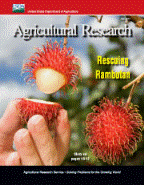United States Department of Agriculture: Agricultural Research Service, Lincoln, Nebraska

Agricultural Research Magazine
Date of this Version
7-2013
Document Type
Article
Citation
Agricultural Research July 2013
Abstract
Land managers are always hoping for the next best thing to help them figure out where they should spend their time and money restoring and maintaining healthy rangelands. Now Agricultural Research Service rangeland ecologist Brandon Bestelmeyer has one of the answers—an ecological-state map that identifies where rangeland is holding its own, where it could respond to restoration efforts, or where it’s already past the point of no return.
“We wanted to find a way to turn existing field-level rangeland assessments into broader tools for comprehensively managing larger landscapes,” says Bestelmeyer, who works at the ARS Jornada Experimental Range in Las Cruces, New Mexico. Working with U.S. Bureau of Land Management (BLM) rangeland specialist Philip Smith and others, Bestelmeyer began pairing time-tested soil data and vegetation maps with state-and-transition models (STMs) to generate science-based assessments of rangeland conditions across landscapes.
STMs describe the types of plant communities that can occur on a specific soil type and the shifts that occur among plant communities. Sometimes, beneficial plant communities have persisted through past events. Other times these plant communities have been so altered by invasive plants, soil degradation, or other processes that they require management interventions— reseeding, herbicide treatments, changes to grazing, or other approaches—to be restored, if they can be restored at all.
A Worksite in the West
The team used around 6 million acres in southwestern New Mexico for the study. This area features large expanses of public and private land with desert grassland, savanna, and shrubland. Native shrubs have been encroaching on areas previously covered by perennial grasses, and erosion has degraded soils throughout much of the region.
The researchers started developing three ecological-state categories for plant communities by defining how woody-cover density varies among different soils. They determined this by identifying the vegetation they believed had historically dominated a particular soil. The categories were “little woody cover,” “significant woody plant cover within a grassland matrix,” and “dominated by woody plants.”
Included in
Agriculture Commons, Animal Sciences Commons, Food Science Commons, Plant Sciences Commons

